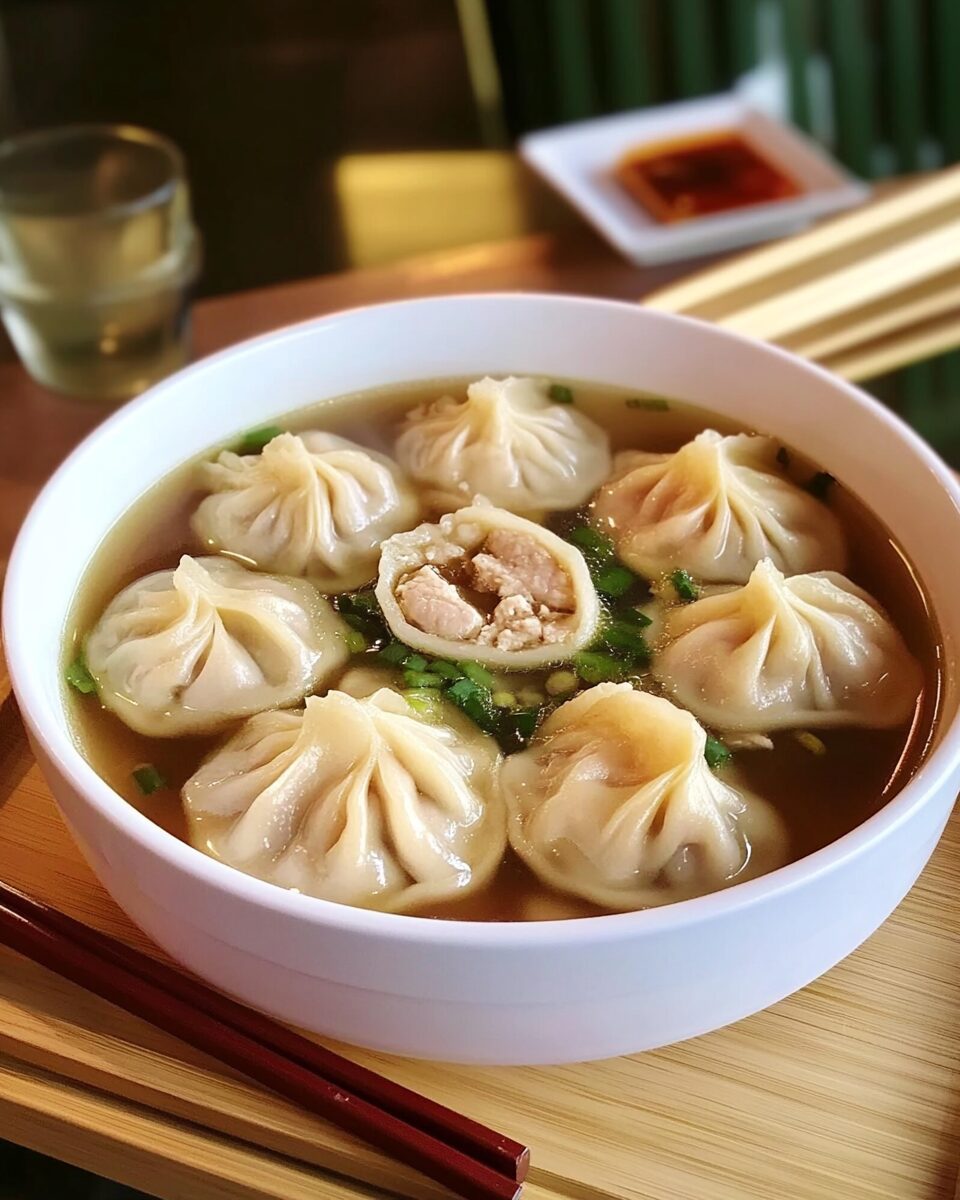The delicate folds, rich pork filling, and explosive broth make these Pork Soup Dumplings a truly unforgettable dish. Inspired by classic xiao long bao, this recipe brings authentic Chinese flavors into your home kitchen using accessible ingredients and an approachable method.
Making them from scratch might take time, but it’s a rewarding journey—especially when the steam lifts and you bite into that savory, soupy center. Serve them hot with a tangy soy-vinegar-sambal dip, and you’ve got a restaurant-worthy experience at your fingertips. Perfect for a weekend culinary project or a cozy night in with friends and family.
Full Recipe:
Wrappers:
3 cups all-purpose flour, plus more for dusting
1 1/2 teaspoons kosher salt
1/2 cup boiling water
1/2 cup cold water
Soup Gelatin:
1 3/4 cups chicken stock
1 tablespoon soy sauce
1 tablespoon gelatin powder (one 1/4-ounce envelope)
Filling:
1 pound ground pork
1/2 teaspoon kosher salt
2 tablespoons soy sauce
1 tablespoon finely grated fresh ginger
1 tablespoon sambal oelek
1 tablespoon sesame oil
1 tablespoon rice vinegar
4 scallions, finely chopped
Directions:
Make the Dough:
Combine flour and salt in a large bowl. Add boiling water, mix with a spatula, then incorporate cold water. Knead until a smooth, slightly sticky dough forms (7–10 minutes). Cover with a damp towel and let rest for 30 minutes.Make Soup Gelatin:
Heat chicken stock, stir in soy sauce and gelatin until dissolved. Pour into a shallow dish and chill for about 1 hour until set. Fluff with a fork to break into small pieces.Make Filling:
In a large bowl, combine ground pork, salt, soy sauce, ginger, sambal oelek, sesame oil, rice vinegar, and scallions. Mix gently with hands until just combined.Assemble Dumplings:
Divide dough into 32 balls. Roll each into a 3½ to 4-inch round. Add ½ tablespoon pork filling and ½ tablespoon soup gelatin to the center. Pleat and pinch closed.Steam Dumplings:
Line a bamboo steamer with parchment or cabbage leaves. Place dumplings inside, leaving space between. Set steamer over boiling water. Steam 8–10 minutes in batches until cooked through.Serve:
Serve warm with a dipping sauce of soy sauce, vinegar, and sambal oelek.
Prep Time: 40 minutes | Cooking Time: 10 minutes per batch | Total Time: 2 hours 40 minutes (including rest & chilling time)
Kcal: Approx. 80 kcal per dumpling | Servings: 32 dumplings
Introduction to Pork Soup Dumplings
Pork Soup Dumplings, commonly known by their Chinese name Xiao Long Bao (小笼包), are a culinary marvel hailing from the Jiangnan region of China, particularly associated with Shanghai. These delicate, steamed parcels are adored not just for their savory pork filling, but for the rich, flavorful broth that bursts in your mouth with every bite. Unlike traditional dumplings, soup dumplings are a complex combination of texture, flavor, and technique, which transforms a simple dish into a sensory experience.
For many food enthusiasts, the magic of soup dumplings lies in the engineering behind them. How does a dumpling contain hot soup without leaking? The answer: gelatin-rich broth that melts during steaming. This scientific touch, combined with culinary craftsmanship, makes Pork Soup Dumplings an irresistible highlight of Chinese cuisine.
A Brief History of Xiao Long Bao
The origins of soup dumplings trace back to the late 19th century in Nanxiang, a suburb of Shanghai. These dumplings were first served as a tea-house delicacy, offering a comforting and novel twist on traditional steamed buns. Over time, the dish gained immense popularity, spreading across China and eventually the globe.
Xiao Long Bao translates to “little basket buns,” referencing the bamboo steamers traditionally used to cook them. Unlike larger buns or dim sum dumplings, these are smaller, intricately pleated, and often eaten in one or two bites. They are considered a form of dim sum, but their unique preparation and soup-filled center set them apart in both reputation and execution.
What Makes Pork Soup Dumplings Special
What sets Pork Soup Dumplings apart from regular dumplings or potstickers is the presence of rich, aromatic broth inside the wrapper. This broth isn’t added in liquid form—instead, it is made by cooling a gelatin-thickened stock and chopping it into small cubes, which are then mixed with the pork filling. When the dumpling is steamed, the gelatin melts into a savory soup.
Each component of the dumpling has to be just right: the dough must be pliable yet strong, the pleats must be consistent to seal in the soup, and the filling must balance savory richness with subtle aromatics like ginger, scallions, and sesame oil. These dumplings are not just food—they’re a test of a cook’s technique and finesse.
Cultural Significance in Chinese Cuisine
In Chinese culture, dumplings are more than just a meal; they symbolize unity, celebration, and prosperity. Soup dumplings, in particular, often appear at festive gatherings, special occasions, and high-end dim sum restaurants. Their intricate nature means they are usually made with care and attention, often in a group setting where family or friends gather to pleat and stuff them together.
In modern culinary circles, Pork Soup Dumplings have become a staple in international dim sum menus and food festivals, offering a taste of traditional Chinese culture in a refined, exciting way. They’re both comfort food and culinary art, making them popular among chefs and home cooks alike.
Techniques and Challenges of Making Soup Dumplings
Crafting soup dumplings at home can be a rewarding yet ambitious endeavor. One of the biggest challenges lies in the dough. It must be rolled thinly enough to remain delicate and allow visibility of the soup inside, yet be strong enough to hold the filling and broth without tearing during the steaming process.
The soup gelatin, made from high-quality stock, also requires precise timing. It must be chilled until firm before incorporating into the filling, and then handled delicately to avoid premature melting. The pleating process, traditionally involving 18 folds to close each dumpling, demands skill and practice. Even seasoned cooks often need multiple tries before achieving picture-perfect dumplings.
Another consideration is steaming. The dumplings are typically placed on cabbage leaves or perforated parchment paper inside a bamboo steamer to prevent sticking and allow even steam circulation. Overcrowding the steamer or letting moisture accumulate under the dumplings can lead to soggy, broken wrappers.
Tasting and Serving Suggestions
Soup dumplings are best enjoyed fresh out of the steamer, when the broth is piping hot and the wrapper tender. The traditional way to eat them is to place the dumpling in a Chinese soup spoon, nibble a small hole to sip the broth, and then consume the rest in one or two bites.
They’re often served with a dipping sauce made from a simple mix of soy sauce and Chinese black vinegar, sometimes enhanced with julienned ginger or a touch of chili paste like sambal oelek. The contrast of the tangy sauce with the rich broth creates a satisfying balance that elevates the dumplings even further.
Variations and Modern Twists
While traditional Pork Soup Dumplings remain a gold standard, modern chefs have taken creative liberties to reinvent the dish. You’ll find variations using chicken, crab, shrimp, or even vegetarian fillings made with mushrooms and tofu. Some versions use colored wrappers made with spinach or beetroot juice for visual flair.
In high-end restaurants, soup dumplings may be served with edible gold leaf, foie gras fillings, or smoked broths to cater to gourmet tastes. On the other hand, street vendors might stick with the classic but offer giant soup dumplings served with a straw to sip the soup directly—a fun, contemporary twist.
Health Considerations
While undeniably delicious, Pork Soup Dumplings are typically a treat rather than an everyday meal. They are high in sodium due to the broth and sauces, and the dumpling wrappers are carbohydrate-dense. However, when made at home, they can be customized to be slightly healthier by using leaner pork, low-sodium broth, or by adjusting the amount of oil and soy sauce in the filling.
Additionally, the steaming method is much healthier compared to deep-frying, and the portion-controlled nature of dumplings makes them an excellent option for mindful eating when served with a side of steamed vegetables or a light soup.
Tips for First-Time Dumpling Makers
For beginners looking to try their hand at making Pork Soup Dumplings at home, patience is key. Start by mastering the dough and practice rolling even, thin circles. Use a small cookie scoop to maintain consistent filling sizes, and don’t worry if your first few dumplings aren’t picture-perfect—what matters most is sealing them well to hold the soup.
Freezing extra dumplings is a great time-saving trick. Once assembled, freeze them on a tray until solid, then transfer to a bag. They can be steamed directly from frozen, making them a great make-ahead dish for future cravings.
It’s also worth investing in a bamboo steamer if you plan on making dumplings regularly. The traditional vessel not only adds a light woody aroma but also ensures even cooking without condensation pooling under the dumplings.
Conclusion: A Masterpiece in a Bite
Pork Soup Dumplings are the kind of dish that tells a story—from the culinary ingenuity of using gelatinized broth to the cultural significance in Chinese traditions. Whether you’re savoring them at a dim sum palace or rolling dough in your own kitchen, the experience is one of joy, warmth, and connection.
Their complexity is part of their charm. With each bite, you taste layers of tradition, innovation, and technique. While they may take time and effort to perfect, the result is worth every second. Pork Soup Dumplings are not just food; they’re a celebration of culinary art and shared heritage, wrapped up in one steamy, satisfying parcel.






